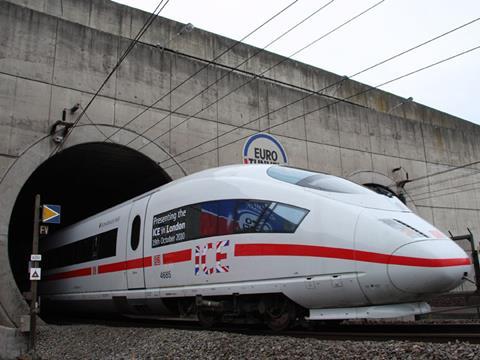
EUROPE: There is no intrinsic reason why trainsets with distributed traction should be banned from operating through the Channel Tunnel, according to a Technical Opinion issued by the European Railway Agency on March 21.
The Channel Tunnel Intergovernmental Commission had asked ERA to review its findings on proposed changes to Eurotunnel’s operating rules, which were outlined on March 31 2010 following consultation with both current operators and potential open access applicants.
ERA was asked to review the safety and operating rules which currently restrict the types of locomotives and rolling stock permitted to use the Tunnel, following suggestions by the French government that the use of Siemens Velaro trainsets as proposed by both Eurostar and Deutsche Bahn would impact on safety because of the use of distributed traction.
In its 44-page document, ERA finds that the current regulations ‘are not in line with EU legislation’ with regard to the Railway Interoperability Directive or the Railway Safety Directive. The regulatory arrangements put in place under the auspices of the Treaty of Canterbury pre-date EU railway legislation on infrastructure separation, open access, safety management and cross-acceptance. However, the Channel Tunnel is now defined as part of the trans-European high speed rail network, bringing it within the scope of high speed TSIs, plus the TSIs on Persons with Reduced Mobility and Safety in Rail Tunnels.
Noting that the IGC ‘carries out the tasks of the National Safety Authority, as provided for in the Railway Safety Directive, has the role of the regulatory body under Directive 2001/14, and is entrusted with establishing the technical rules in line with the Railway Interoperability Directive’, ERA says ‘it is unclear how the IGC discharges all of these responsibilities.’ It suggests that ‘a move to consistency with other networks and a holistic approach, taking account of the EU legislation and 25 years of scientific and technical development, may give the opportunity for reasonably practicable improvements in the overall level of safety.’
ERA’s Technical Opinion then focuses on the 10 concepts covered by the IGC’s letter of March 31 2010:
b) Traction requirements;
c) Traction Systems (distributed traction) and extinguishing of fires in traction units;
d) Smoke penetration protection systems and door joints;
e) Minimum length of train;
f) Multiple unit trains (through corridor);
g) Splittability (the ability to split trains);
h) Electric traction (no diesels);
i) Fire protection standards for design of vehicles and their fittings;
j) Call buttons at the end of each coach.
Of these, ERA notes that items d, e and f had not been notified to the European Commission under Article 7.4.1 of TSI SRT, and others had not been fully covered by the notification.
ERA’s view is that ‘the existing requirements for vehicle authorisation in the Channel Tunnel are not clearly established, published and notified as technical rules’. It says any rules for vehicle authorisation should meet the EU legal framework, with specific rules only allowed where items are not covered by the TSIs or are necessary for ‘technical compatibility’ with the infrastructure.
ERA wants to see a ‘general analysis of the rule system with the aim of defining the necessary sets of technical and safety rules applicable to all trains’. It notes that the Railway Safety Directive ‘requires the maintenance of at least the overall level of safety and the need to comply with the TSIs. This should not be used to justify individual rules that are not in line with a TSI’.
ERA notes that rules on minimum train length, smoke tightness and through corridor requirements relate specifically to the evacuation of the existing Eurostar ‘Three Capitals’ trainsets, and that ‘another scenario has already been accepted for the authorisation of other passenger-carrying trains, such as the lorry shuttles and shorter North of London Eurostar trains’. It believes that the rules for vehicle authorisation ‘should move towards conformity with the EU regulatory framework’, allowing each Railway Undertaking ‘to develop its own evacuation scenario as part of its overall safety management system’, taking account of the requirement for free movement of TSI-compliant vehicles.
ERA endorses the IGC’s findings regarding the abolition of rules on splittability, fire protection standards and call buttons. It says specific rules on traction performance and coupling can also be abolished, as these should be covered by the Network Statement and general rules on compatibility with the infrastructure. More work is required to determine whether the ban on diesel traction should continue.
Noting that the 30 min running time for fire safety is related to the evacuation scenarios, ERA says the member states should investigate the conditions required to permit the operation of trains conforming with the 15 min specified under TSI SRT.
On the thorny question of distributed traction, ERA concludes that ‘the notified rules do not explicitly prohibit distributed power’ and ‘there is no justification for any discrimination between the two traction design configurations’. It does not believe there is any justification for a further study, suggesting that ‘any traction configuration’ that ‘meets the appropriate generic requirements for fire safety’ as set out in the TSIs ‘should be allowed’.

















